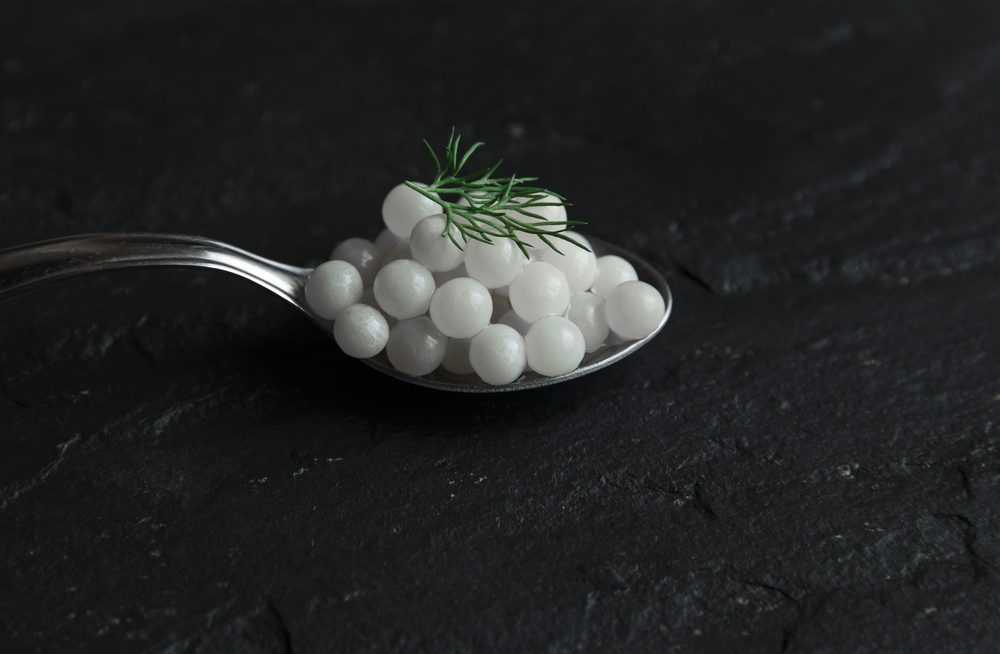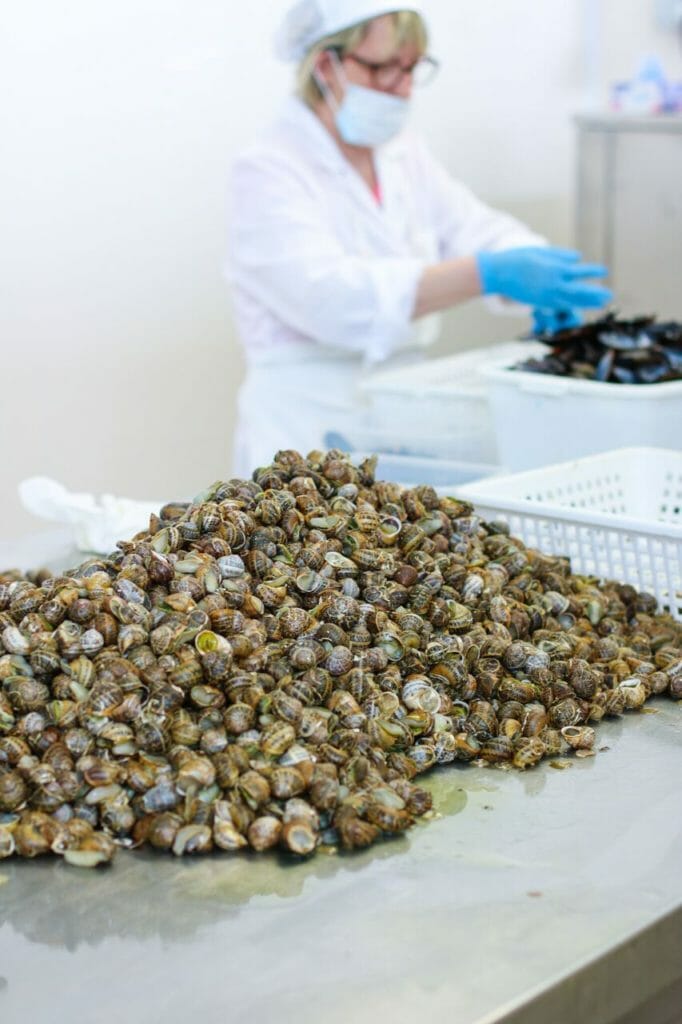Italian Snail Farmers Slide into Caviar Scene
From eggs to cosmetic slime, Italy's snail breeders are finding new ways forward.
Italian Snail Farmers Slide into Caviar Scene
From eggs to cosmetic slime, Italy's snail breeders are finding new ways forward.

Snail caviar. by koss13/Shutterstock
Wild prawns with sour cream. Pancetta wafers with purple potato. Steak tartare with stracciatella cheese. These are the elegant dishes that celebrated Italian chefs are finishing with a curious garnish: snail caviar.
“It’s a flavor that’s incomparable with any other kind of food,” says Davide Merlino, owner of La Lumaca Madonita—Italy’s largest snail farm, located in Sicily—which produces the jarred, fresh snail eggs. Boasting a mineral, herbaceous aroma that’s reminiscent of damp earth, Merlino’s caviale di lumaca comes in at around $1,900 per kilogram, while other brands have sold for more than $3,000 per kilogram. Merlino says the high cost can be attributed to the long and difficult process required to produce the eggs.
Used to produce snail meat and snail caviar, Helix aspersa is the most common species of farmed edible snail in Italy. Called petit-gris in French, it’s native to the Mediterranean and western Europe. The snails lay their eggs into soil; breeders leave glasses inside sterilized earth to catch the precious deposits, then painstakingly sort through them and discard any eggs that aren’t perfectly round or white. The whole process can take up to 150 days, and one snail can only lay around 50 to 100 eggs each year. “We have to harvest the little pearls one by one using tweezers,” Merlino says.
He adds that, right now, snail caviar is most popular in France and Italy—where he’s supplied a number of celebrated fine diners—and he distributes to Switzerland, Russia and Dubai. Snail eggs are eaten raw, and Merlino says they match well with tartares of fish, prawn or beef, because they’re delicate and mineral.
While still a niche product used mostly for high-end food service, the interest in snail caviar follows the recent burgeoning of Italy’s heliciculture (snail farming) industry. According to Coldiretti—the country’s peak agricultural association— snail consumption has increased in Italy by 325% over the last 20 years, and domestic interest in breeding is growing, with local snail production now meeting around half the demand from the Italian market.
Cheerleading the growth of Italian snail farming is the International Institute of Heliciculture, based in the small town of Cherasco near the border with France. Launched some 40 years ago, it’s dedicated to researching snail-breeding techniques, developing snail-based products and connecting breeders around the world, as well as working with some 500 local breeders.

“From its spiral, a whole world is born,” says the institute’s director, Simone Sampò.
He discusses the economic potential of these slow-moving molluscs while leading a tour of their experimental breeding enclosures. “You can transform a plate of food, and you also have the eggs and the slime.” Sampò’s MullerOne invention—or “snail spa” as he calls it—is apparently the first device to harvest cruelty-free snail slime. Said to hold special properties that boost collagen and fight wrinkles, snail slime is fast appearing in cosmetics and skincare, presenting yet another opportunity for breeders. At a luxurious Cherasco day spa, you can even lie back in a bathrobe and have the live, slimy gastropods inch across your face.
In Italy, snail gastronomy is nothing new, but renewed interest in edible snails is emerging elsewhere, too. There is only a small number of USDA-registered snail farms, including one run by a former Noma chef on Long Island—Peconic Escargot is supplying fresh snails and snail caviar to the likes of Eleven Madison Park and Frenchette in NYC. Can’t make it to the Big Apple? You might like to try the critters roaming your own backyard.
Follow us
This work is licensed under a Creative Commons Attribution-NoDerivatives 4.0 International License.
Want to republish a Modern Farmer story?
We are happy for Modern Farmer stories to be shared, and encourage you to republish our articles for your audience. When doing so, we ask that you follow these guidelines:
Please credit us and our writers
For the author byline, please use “Author Name, Modern Farmer.” At the top of our stories, if on the web, please include this text and link: “This story was originally published by Modern Farmer.”
Please make sure to include a link back to either our home page or the article URL.
At the bottom of the story, please include the following text:
“Modern Farmer is a nonprofit initiative dedicated to raising awareness and catalyzing action at the intersection of food, agriculture, and society. Read more at <link>Modern Farmer</link>.”
Use our widget
We’d like to be able to track our stories, so we ask that if you republish our content, you do so using our widget (located on the left hand side of the article). The HTML code has a built-in tracker that tells us the data and domain where the story was published, as well as view counts.
Check the image requirements
It’s your responsibility to confirm you're licensed to republish images in our articles. Some images, such as those from commercial providers, don't allow their images to be republished without permission or payment. Copyright terms are generally listed in the image caption and attribution. You are welcome to omit our images or substitute with your own. Charts and interactive graphics follow the same rules.
Don’t change too much. Or, ask us first.
Articles must be republished in their entirety. It’s okay to change references to time (“today” to “yesterday”) or location (“Iowa City, IA” to “here”). But please keep everything else the same.
If you feel strongly that a more material edit needs to be made, get in touch with us at [email protected]. We’re happy to discuss it with the original author, but we must have prior approval for changes before publication.
Special cases
Extracts. You may run the first few lines or paragraphs of the article and then say: “Read the full article at Modern Farmer” with a link back to the original article.
Quotes. You may quote authors provided you include a link back to the article URL.
Translations. These require writer approval. To inquire about translation of a Modern Farmer article, contact us at [email protected]
Signed consent / copyright release forms. These are not required, provided you are following these guidelines.
Print. Articles can be republished in print under these same rules, with the exception that you do not need to include the links.
Tag us
When sharing the story on social media, please tag us using the following: - Twitter (@ModFarm) - Facebook (@ModernFarmerMedia) - Instagram (@modfarm)
Use our content respectfully
Modern Farmer is a nonprofit and as such we share our content for free and in good faith in order to reach new audiences. Respectfully,
No selling ads against our stories. It’s okay to put our stories on pages with ads.
Don’t republish our material wholesale, or automatically; you need to select stories to be republished individually.
You have no rights to sell, license, syndicate, or otherwise represent yourself as the authorized owner of our material to any third parties. This means that you cannot actively publish or submit our work for syndication to third party platforms or apps like Apple News or Google News. We understand that publishers cannot fully control when certain third parties automatically summarize or crawl content from publishers’ own sites.
Keep in touch
We want to hear from you if you love Modern Farmer content, have a collaboration idea, or anything else to share. As a nonprofit outlet, we work in service of our community and are always open to comments, feedback, and ideas. Contact us at [email protected].by Alecia Wood, Modern Farmer
September 15, 2019
Modern Farmer Weekly
Solutions Hub
Innovations, ideas and inspiration. Actionable solutions for a resilient food system.
ExploreShare With Us
We want to hear from Modern Farmer readers who have thoughtful commentary, actionable solutions, or helpful ideas to share.
SubmitNecessary cookies are absolutely essential for the website to function properly. This category only includes cookies that ensures basic functionalities and security features of the website. These cookies do not store any personal information.
Any cookies that may not be particularly necessary for the website to function and are used specifically to collect user personal data via analytics, ads, other embedded contents are termed as non-necessary cookies.
Hi, I’d like to know about helix aperta and helix aspirsa.
Thanks